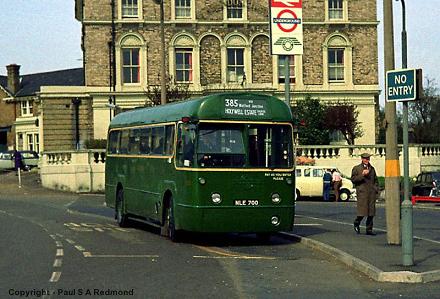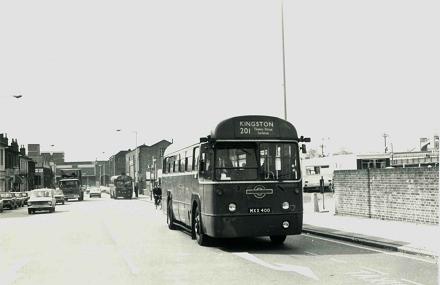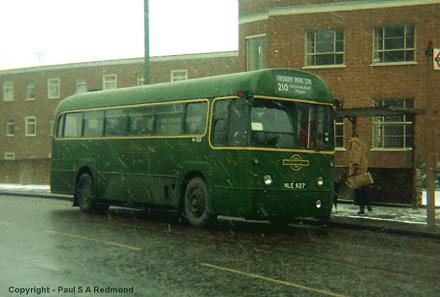|
|
 The RF Story The RF Story
Part 4 - Rejuvenation
RF700, the last RF to be
delivered and one of three converted for one-man operation before
entering service.
It is seen at Watford
Junction in London Country days.
Photo © Paul Redmond
One-man operation
Although ideally laid out for one-man operation, this was not
the plan initially as Regulations limited the capacity of
one-man buses to 26 (recently increased from 20).
However, pioneering one-man operation (OMO) in Huddersfield
led LT to experiment, with the result that three of the
new Country buses were modified before entering service.
These changes were more extensive than those undertaken
subsequently, involving a wider cab with a full-height
door. Changes that took place on all OMO bus
conversions included a reduction in seating to 39, by the
shortening by two seats of the nearside bench seat and the
installation of a luggage pen, and the provision of a driver's
external emergency door.
The three experimental buses, RFs 517, 647 and 700 went into
service from Leatherhead garage in March 1954 on Epsom local route
419, followed by a northern trial on the 316 later that year.
The trials were successful and all the country buses were converted
for one-man-operation by March 1959, although it took until 1966 to
convert all Country Area RF routes to OMO.
 Pictured in the days when Kingston's Wood Street was
one way westwards, and formed part of the loop past Bentalls that
the 201 followed on its way in to
Kingston Bus Station, RF423 passes Kingston Station in April 1973
followed by another red RF. The 201 was one of the first four
Central Area routes converted to OMO nine years earlier. Photo © Jim Blake
Conversion of red RFs for one-man operation started in 1959,
once the country bus fleet was done. This involved fitting
doors (with consequent changes to handrails) as well as the other
changes that applied to the green buses; the buses chosen were the
(then) highest numbered red RFs, 502 to 538, in order that the
complete sequence from RFs 502 to 700 should be suitable for
OMO.
However, union agreement to Central Area driver-only operation
had lapsed with the last of the Cubs in
1949 and was not forthcoming. It took five years before
agreement was reached, with the conversion to OMO on 18 Nov 64 of
four less busy routes - 201, 206, 216 and
250 (the first three in the Kingston
area, the fourth in rural Essex). Conversion to OMO continued
with the last crew single-deck route, the 236, losing its conductors on 16 Apr 71.
However, by now RFs were being replaced by Swifts; not all of the
crew red RFs were converted and surplus buses were sold.
The first OMO Green Line route was the 724, from its
introduction on 10 Jul 66; hitherto all Green Line services had
been crew-operated. The success of this and the 727
(introduced in 1967) sealed the fate of Green Line
conductors. The remaining single-deck routes were converted
to OMO in November 1968 and March 1969.
Other changes
The most prominent change to the RF fleet was the
modernisation of the Green Line fleet in 1966/7. This
involved fitting twin headlamps, a curved windscreen and new livery
inside and out, with a striking wide pale green band around the
outside of the coaches. By this time, some of the Green Line
coaches had been converted to buses (including a few that had
earlier been converted from red buses to coaches), leaving a total
of 175 RFs to be modernised. The first was RF136 (which had
detailed differences from the others) in March 1966 and the last
was RF63 in July 1967.
 In addition
to the six red buses converted to coaches in 1957, ten Private Hire
coaches and 19 green buses were added to the Green Line fleet at
the same time. Later, as Routemasters replaced Green Line RFs
and as the service declined, many Green Line RFs were transferred
to the green bus fleet. This included some of the modernised
RFs, which then gained yellow bands similar to those worn by the
Country Area Merlins introduced in 1968. Finally, 13 green
buses were permanently transferred to the Central Area on 1 Jan 69,
where they ran in green livery on the
210 before being painted red.
RF627 was one of the
thirteen country buses transferred in to Muswell Hill in January
1969, where it experiences some seasonal weather while
working the 210. The bus was repainted red in July 1969 (but
is now preserved in green livery).
Photo © Paul Redmond
As with any sizeable fleet, there were detailed changes
through the life of the RF. Some of the more noticeable were
as follows:
- The addition of a handrail across the nearside front
window, for safety reasons, in the mid-50s.
- The fitting of indicator 'ears' in 1959, following an
experimental batch in 1956. As with the RTs, these replaced
the semaphore trafficators that had
not been a success and were largely unused.
- Also as for the RTs, the rear indicator with a doubleheaded arrow was replaced by
arrows on both left and right and rear reflectors were added (note
that we use the term indicator for 'trafficator'; in LT parlance,
an indicator was a blind display).
- A experimental pale green livery was
applied to 16 Green Line RFs in 1960 but was not adopted as
standard.
- The nearside route number boxes, and the external side
advertisements above the windows, were removed from red buses
in the early 1960s.
- Buses were fitted with saloon heaters, from 1962 in the Country
Area and from 1963 on red buses.
|
|